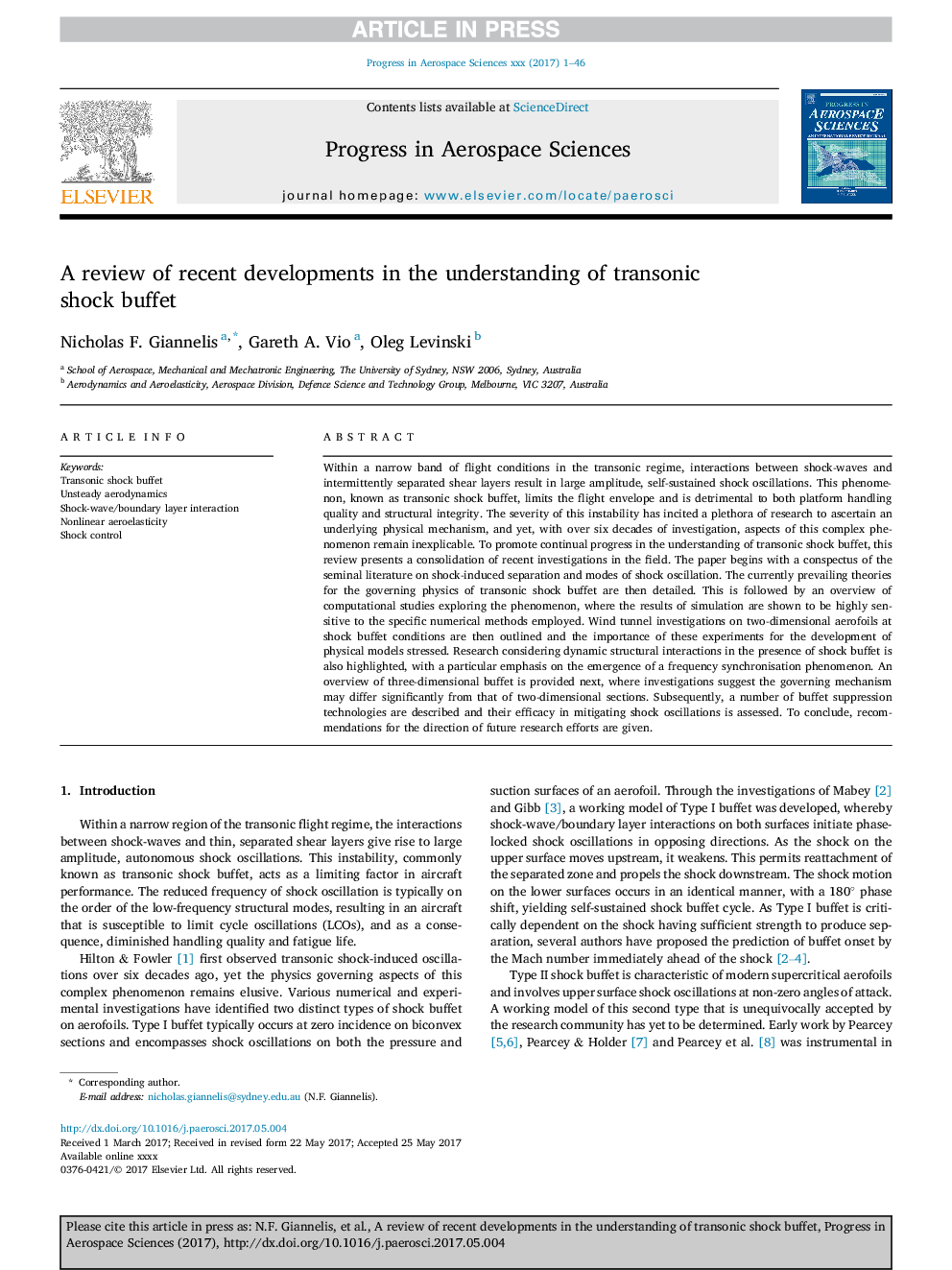| کد مقاله | کد نشریه | سال انتشار | مقاله انگلیسی | نسخه تمام متن |
|---|---|---|---|---|
| 5473129 | 1520144 | 2017 | 46 صفحه PDF | دانلود رایگان |
عنوان انگلیسی مقاله ISI
A review of recent developments in the understanding of transonic shock buffet
ترجمه فارسی عنوان
بررسی پیشرفت های اخیر در درک شوک بوکسور تراونیک
دانلود مقاله + سفارش ترجمه
دانلود مقاله ISI انگلیسی
رایگان برای ایرانیان
کلمات کلیدی
ترجمه چکیده
در یک گروه باریک از شرایط پرواز در رژیم ترانسونیک، تعامل بین امواج شوک و لایه های برشی متناوب جدا شده منجر به دامنه وسیعی، نوسانات شوک خودکشی می شود. این پدیده شناخته شده به عنوان بوفه شبیه ساز تراشه، بسته بندی پرواز را محدود می کند و برای هر دو سیستم عامل با کیفیت و یکپارچگی ساختاری مضر است. شدت این بی ثباتی موجب فراوانی تحقیقات برای تشخیص مکانیسم فیزیکی پایه شده است، اما با بیش از شش ده سال تحقیق، جنبه های این پدیده پیچیده، غیر قابل توضیح است. برای ترویج پیشرفت مستمر در درک شوک تراجنسی تراون، این بررسی ترکیبی از تحقیقات اخیر در این زمینه است. این مقاله با نظریۀ ادبیات ذهنی در مورد جدایی ناشی از شوک و حالت های نوسان شون آغاز می شود. سپس نظریه های در حال حاضر غالب برای فیزیک حاکم بر بوفه شوک تراونیشان مفصل است. این به دنبال یک مرور کلی از مطالعات محاسباتی برای کاوش در پدیده است، که در آن نتایج شبیه سازی نشان داده شده است که بسیار حساس به روش های عددی خاص استفاده می شود. سپس بررسی های تونل باد در مورد آئروفویل های دو بعدی در شرایط بوفه شوک مشخص می شود و اهمیت این آزمایش ها برای توسعه مدل های فیزیکی تأکید شده است. تحقیق با توجه به تعاملات ساختاری پویا در حضور بوفه شوک، با تاکید خاص بر ظهور پدیده هماهنگ سازی فرکانس، مشخص شده است. در ادامه، یک مرور کلی از سه بعدی بوفه، جایی که تحقیقات نشان می دهد مکانیسم حاکمیت ممکن است به طور قابل توجهی از بخش های دو بعدی متفاوت باشد ارائه شده است. بعدها، تعدادی از فن آوری های سرکوب کننده بوفه، شرح داده شده و اثربخشی آنها در کاهش نوسانات شوک ارزیابی می شود. برای نتیجه گیری، توصیه هایی برای جهت تلاش های پژوهشی آینده ارائه شده است.
موضوعات مرتبط
مهندسی و علوم پایه
سایر رشته های مهندسی
مهندسی هوافضا
چکیده انگلیسی
Within a narrow band of flight conditions in the transonic regime, interactions between shock-waves and intermittently separated shear layers result in large amplitude, self-sustained shock oscillations. This phenomenon, known as transonic shock buffet, limits the flight envelope and is detrimental to both platform handling quality and structural integrity. The severity of this instability has incited a plethora of research to ascertain an underlying physical mechanism, and yet, with over six decades of investigation, aspects of this complex phenomenon remain inexplicable. To promote continual progress in the understanding of transonic shock buffet, this review presents a consolidation of recent investigations in the field. The paper begins with a conspectus of the seminal literature on shock-induced separation and modes of shock oscillation. The currently prevailing theories for the governing physics of transonic shock buffet are then detailed. This is followed by an overview of computational studies exploring the phenomenon, where the results of simulation are shown to be highly sensitive to the specific numerical methods employed. Wind tunnel investigations on two-dimensional aerofoils at shock buffet conditions are then outlined and the importance of these experiments for the development of physical models stressed. Research considering dynamic structural interactions in the presence of shock buffet is also highlighted, with a particular emphasis on the emergence of a frequency synchronisation phenomenon. An overview of three-dimensional buffet is provided next, where investigations suggest the governing mechanism may differ significantly from that of two-dimensional sections. Subsequently, a number of buffet suppression technologies are described and their efficacy in mitigating shock oscillations is assessed. To conclude, recommendations for the direction of future research efforts are given.
ناشر
Database: Elsevier - ScienceDirect (ساینس دایرکت)
Journal: Progress in Aerospace Sciences - Volume 92, July 2017, Pages 39-84
Journal: Progress in Aerospace Sciences - Volume 92, July 2017, Pages 39-84
نویسندگان
Nicholas F. Giannelis, Gareth A. Vio, Oleg Levinski,
